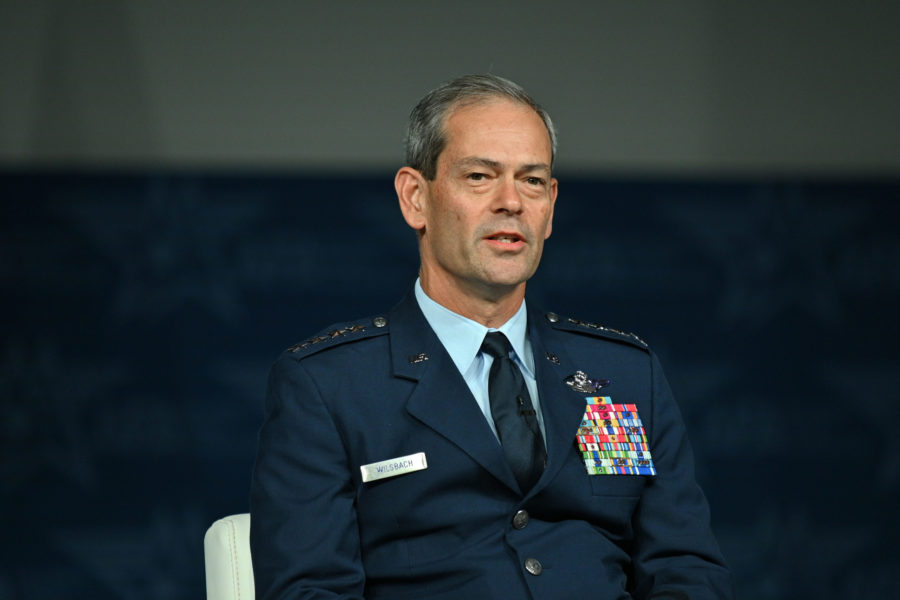AURORA, Colo.—F-22s flying from a bare-bones base on Tinian earlier this month is proof positive that no part of the Air Force is exempt from practicing Agile Combat Employment.
The F-22s deploying to remote Pacific island was a first for the Raptor, and represented a high-profile example of ACE training in the Pacific, said Gen. Kenneth S. Wilsbach in a press briefing at the AFA Warfare Symposium.
First introduced by PACAF several years ago, ACE is the operational concept of dispersing teams of multi-capable Airmen to operate from remote or austere locations in a “hub-and-spoke” manner to make air units more survivable and make targeting them harder for an adversary. Tinian, some 100 miles from Guam and thousands of miles from any major land mass, fits the bill of remote and austere.
“There’s not much [on Tinian],” Wilsbach noted. “There’s a runway, a taxiway, a very small ramp, and a very small terminal which acts as the commercial terminal and the other half is our ops center. We set up the rest of it with tents and other transportable facilities so that we can actually do our operations. The crews have to operate out of that bare base, they’ve got to stay connected with their parent wing, which was somewhere else, and they have to be able to meet the mission taskings … and all of that’s required to be in the right place at the right time with your airpower to be generated from that airbase.”
The F-22s deployed to Tinian came from Joint Base Elmendorf-Richardson (JBER)’s 525th Expeditionary Fighter Squadron, but Wilsbach made it clear he wants every Airman in PACAF to develop the skills necessary for ACE to work.
“All of our Airmen in PACAF have to be proficient in Agile Combat Employment—not one person is excused from being an ACE Airman, not one Airman is excused from at least being available for being a multi-capable Airmen,” Wilsbach said. “And I’ve told all the Wing Commanders and the Numbered Air Force commanders in PACAF that I expect them to take risks. … As a matter of fact, what all the Wings have done now is they are making ACE a part of their daily training.”
Not all that training is as far-reaching as sending F-22s to remote islands—Wilsbach cited examples of Airmen going outside their typical career field to launch aircraft at bases, or medical personnel setting up tents in parking lots to simulate deployments.
But rotating aircraft and Airmen through places like Tinian strikes at the heart of what ACE is all about, Wilsbach said.
“The whole big picture purpose of ACE is to disperse your forces, so that’s exactly what we’re going to do during a conflict, which is we’re going to have jets spread out over many, many islands like that, and it may only be a few of them,” said Wilsbach. “And it’s to make the targeting problem for the adversary more difficult. It makes them use more munitions. And it gives us the chance to keep airpower in the air to create effects.”
Spreading across multiple remote islands without all the comforts of home creates numerous logistical challenges that can’t simply be solved by taking more equipment for the mission, Wilsbach said.
“To sustain that force for periods of time does take additional logistics,” Wilsbach acknowledged. “And fortunately in the [2022] budget, the ’23 budget, and we’re hopeful in the ’24 budget, there’s a significant amount of dollars that are associated with prepositioning at our hubs and spokes, mainly our spokes so that you have sustainment materiel at those places. So what I’m talking about is fuel parts, support equipment, water and food mainly. And we’re starting to purchase those and put them out at the spokes.”
On Tinian in particular, which the Department of Defense plans to turn into a permanent alternative location for aircraft operating out of Guam, the Air Force is investing “a lot of money,” Wilsbach said, to do things like install fuel storage and extend and expand the number of runways and taxiways.
One thing PACAF will not be doing is trying to harden facilities against missile strikes—Wilsbach said he is “not a big fan” of that practice.
“The reason is because with the advent of precision guided weapons, even a hardened structure” can be destroyed. “They’re not so hard when you put a 2,000-pound bomb right through the roof. In order to make things hard enough for precision-guided weapons, you have to spend just inordinate amounts of resources to make it hard enough so they can withstand the kind of weapons,” Wilsbach said.
Instead, Wilsbach endorsed a strategy of defending bases using systems designed to shoot down incoming threats—and simply having increased numbers of widespread facilities to minimize the impact of any one strike.
“In lieu of hardening places, what we’re spending our infrastructure dollars on this year is sustainment of our main facilities,” Wilsbach said. “From the Agile Combat Employment [account], what we’re spending our dollars on this year is expanding the number of places that we can go to and of the places that we’re already at, expanding the capability of those places.”

